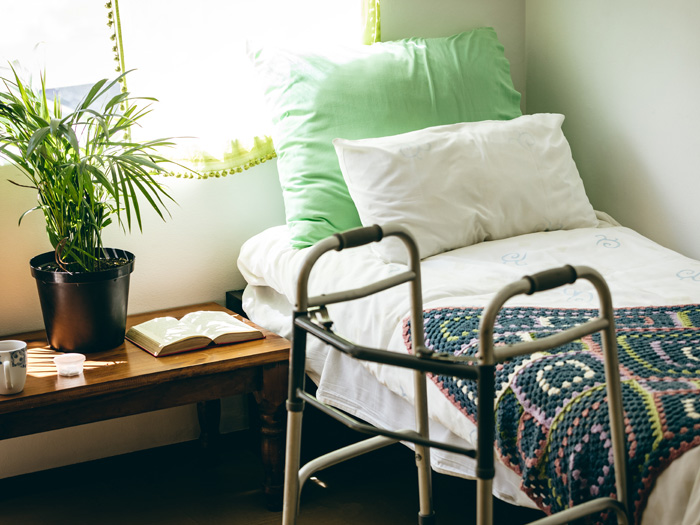COVID-19 Leaves Nursing Homes Grappling to Stay Covered and Safe

COVID-19 has killed more than 10,000 residents and staff at nursing homes in the United States — and that figure only accounts for the 23 states publicly reporting such data. One facility in Brooklyn reported 55 deaths. Another in Minnesota had 47 deaths. Sadly, there are similar stories across the country.
With lockdown orders in effect to protect the vulnerable residents, families gather outside patient windows providing what little encouragement they can with hand-written signs shown from behind panes of glass.
Inside, isolated patients are forced to battle the deadly virus without the physical presence and touch of the people they love most.
The backdrop makes for an uncertain insurance landscape in the long-term care industry. Despite the “silver tsunami” of aging Baby Boomers providing a constant flow of new residents, premiums and deductibles have been rising steadily — long before the pandemic.
Some carriers may see new risks in nursing homes because contagious diseases can easily spread to vulnerable populations. Others may see nursing homes as safe havens with fast access to medical care and dedicated front-line workers who performed heroically in the face of the unprecedented pandemic.
Meanwhile, carriers are astutely aware of the ever-present lawsuits in the industry and new lawsuits surely coming in the wake of COVID-19. No matter what the future holds, expect carriers to write strict norovirus exclusions into their policy language.
Mitigating Risk
Long-term care facilities are doing plenty to mitigate the risk of COVID-19, and they’re using this experience to learn how to manage infectious diseases in the future.
They’re isolating COVID-19 patients in separate wings, taking employees’ temperatures before shifts, utilizing personal protective equipment, and updating their infectious disease policies and crisis-response standards.
They’re quickly implementing the ever-evolving guidelines from the Centers for Disease Control and Prevention and other government agencies — and communicating those changes to residents and families.
It’s a compelling story to tell carriers come renewal time.
“We all see the success and amazing stories of the hospital heroes and rightfully so. But for some reason, we see nursing homes and assisted living stories in a less favorable light,” said Frank Russo, senior vice president of risk management at Healthpeak Properties in Irvine, Calif.
“The work being done at senior housing facilities post-COVID is downright remarkable.”
How will the carriers respond? Prices and deductibles had been high for the past few years before the pandemic. Don’t expect that to stop now, said Joseph Hancock, principal at TrueNorth Companies who places professional and general liability coverage at long-term care facilities.
“Unfortunately they’re making knee-jerk reactions. It’s hard to underwrite such a large unknown,” he said.
Russo argues, however, that if premiums rise in the near future, it’s likely due to uncertainty, not the pandemic.
“They’re not worrying about a significant amount of claims arising from COVID-19, and they’re not worried about future claims because they’re excluding them. But there’s always always a bit of premium increase when the insurance market is uncertain about something,” said Russo.
Litigation Before and After COVID-19
To provide context on the post-pandemic future of long-term care facilities, it’s helpful to examine the economics prior to the outbreak. Russo said the senior housing market was strong and anticipating new waves of residents as Baby Boomers continue to age.
“There was a lot of new construction and a lot of lenders eager to provide financing — that’s a good barometer,” said Russo.
Still, the insurance market had been hardening for quite some time. Hancock said premium prices and deductibles have been climbing for the past few years. The cost is driving many facilities to examine self-insured arrangements like captives or fully funded plans.
“A location I was selling at $1,000 to $1,200 per bed all of a sudden jumped to $3,000 to $5,000 a bed,” said Hancock.
The culprit? Lawsuits.
“The plaintiffs’ bar is becoming more sophisticated and they’re ramping up their advertising. They’re running seminars on how to sue nursing homes. There is a lot of uptick in the number of claims being filed,” Hancock said.
In the wake of COVID-19, the industry could face a new onslaught of lawsuits. For example, families of patients who contracted the virus at a nursing home could claim the facility was negligent in its response to the outbreak. That exposure could be covered by professional liability insurance.
The nursing home industry has pleaded for immunity from the government. So far, six states have provided nursing homes with explicit immunity from coronavirus lawsuits, according to NBC News. Another six offered immunity to health care providers — and nursing home workers could fit that description.
Will legal immunity let potential bad actors off the hook? Anny Figueroa thinks so. Her mother was a resident at Andover Subacute & Rehab Center in New Jersey, “where law enforcement discovered 17 bodies in a makeshift morgue this month,” according to NBC News.
“The plaintiffs’ bar is becoming more sophisticated and they’re ramping up their advertising. They’re running seminars on how to sue nursing homes. There is a lot of uptick in the number of claims being filed.” — Joseph Hancock, principal, TrueNorth Companies
Figueroa said the facility did not initially tell her about her mother’s coronavirus diagnosis. “I can’t even believe this is a topic of discussion,” she told NBC News.
How families will view senior housing in the wake of the crisis is anybody’s guess. Surely, some will only trust nursing homes with their loved ones if a COVID-19 vaccine or treatment becomes available. Others might see the value in having loved ones cared for 24/7 by professionals.
“You’re seeing transactions put on hold, new buildings on hold. It’s a wait-and-see approach,” said Russo.
Hancock argues that in the short term, the hardening insurance market will continue.
“The hardening and increasing cost is going to happen more on a national basis,” said Hancock. “That was just starting to happen pre-COVID, and COVID has caused it to accelerate.” &











